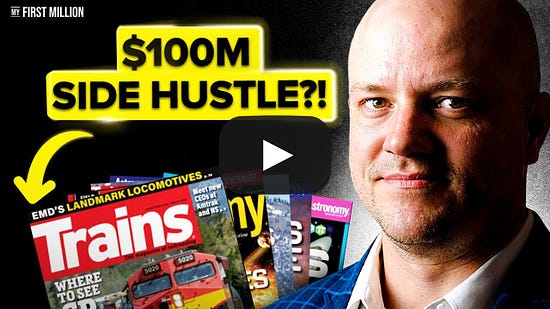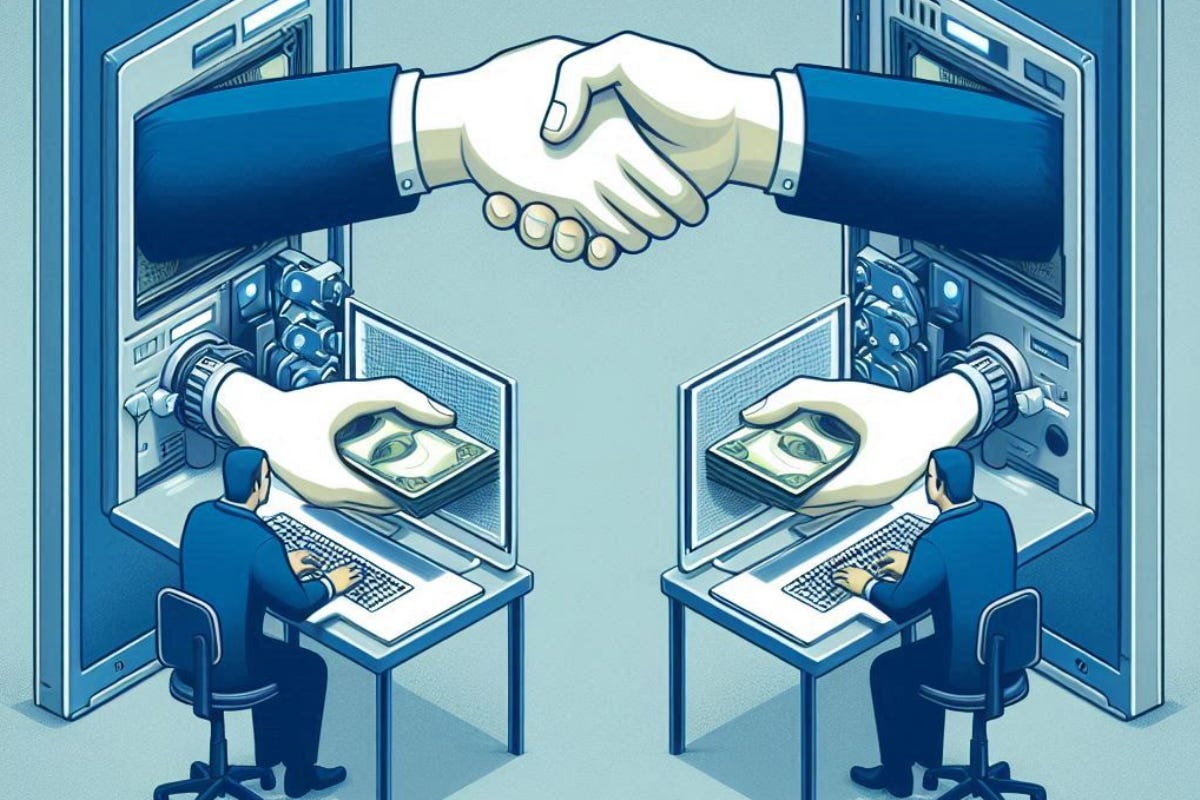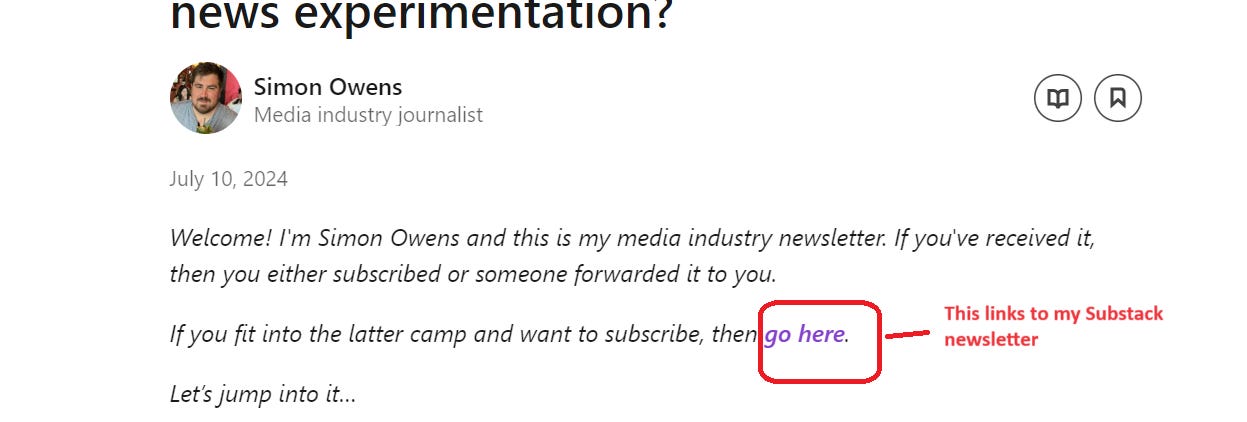The next generation of media companies won’t behave like media companies
The next generation of media companies won’t behave like media companiesPLUS: CNN needs to pivot away from punditry.Welcome! I'm Simon Owens and this is my media industry newsletter. If you've received it, then you either subscribed or someone forwarded it to you. If you fit into the latter camp and want to subscribe, then you can click on this handy little button: Let’s jump into it… Increase Revenue for Your Publishing Business with MembershipFor many publishers, success equals scale. But grinding to reach the widest possible audience and ensuring you're 'advertiser-friendly' often comes at the expense of doing the work you are actually passionate about. There is, however, a more sustainable approach. Enter today’s sponsor Memberful. Diversify your revenue stream with membership, earning income by doing the work you love and your audience values. From gated content and paid newsletters to membership tiers and access to community events, Memberful has all of the features you need to get your membership business up and running. Plus, Memberful seamlessly integrates with all of your favorite tools including MailChimp, WordPress, ConvertKit, and Discord — so there's no need to migrate your platforms or change your workflow. Most importantly, with Memberful you always retain full control and ownership of your audience, your brand, and your business. Learn more about Memberful and get started with a free trial. The next generation of media companies won’t behave like media companiesCraig Fuller is best known as the founder of FreightWaves, a media company that sells a high-priced data product. But as a side hustle he also buys hobbyist magazines and then sells products and services to the hobbyists who read those magazines:  For instance, he bought Flying Magazine, an outlet geared toward people who own private planes and jets. Then he bought a large plot of land in Tennessee, built a small airport at the center of it, and began selling parcels of land to flying enthusiasts who want to build homes around this airport. This is how the next generation of media companies will operate; they won’t necessarily eschew traditional media models like advertising and subscriptions, but their main value will be to drive down customer acquisition costs for some kind of adjacent product or service. Fuller essentially owns a real estate company that markets itself with a magazine. How to incorporate LinkedIn Newsletters into your larger newsletter strategyLinkedIn rolled out a new feature that will allow company pages to buy ads promoting their LinkedIn newsletters:
Before you go spending a bunch of money on LinkedIn buying subscribers for your LinkedIn newsletter, remember that you'll never be able to export your email list and LinkedIn can begin choking off your newsletter distribution at any point. Currently, the stats dashboard doesn’t even tell you if your newsletters are being distributed to the entire subscriber base that signed up for it; you just see a vague “article views” number that combines the people who opened the newsletter in their inbox and those who saw it on LinkedIn. That being said, it’s clear LinkedIn is heavily promoting its own newsletter tool within its network, so there is an opportunity to tap into its massive user base. Since launching my own newsletter on LinkedIn, it’s grown to over 7,000 subscribers; that’s about half the subscribers I have on Substack, though it seems clear that the open rate for my LinkedIn newsletter is much lower. So how do you balance growing a LinkedIn newsletter without undermining your main newsletter strategy? My approach is to try to leverage the LinkedIn newsletter to drive signups for my main newsletter. To start with, I always publish the LinkedIn version on a 12-hour time delay, so as to avoid cannibalizing my main list as much as possible. I also put a call to action at the top of the LinkedIn newsletter to try to drive signups to my main newsletter: And then finally, I always include links within my LinkedIn newsletter that drive people back into the archives of my Substack newsletter. How many signups is this actually driving to my main newsletter? It’s difficult to say. But I’m getting an additional 1,500 views on every LinkedIn newsletter, so my hope is that it’s producing at least some additive value. The Washington Post needs to diversify its coverageDick Tofel published a piece dissecting WashPo’s struggles under Jeff Bezos’s ownership:
A big reason for why WashPo's growth stalled out is because it over-indexed on political news. Not only is that content category super saturated, but interest in politics significantly declines in non-election years. Compare its strategy to the one employed by the New York Times, which has diversified its offerings to recipes, games, product recommendations, and sports — not to mention a wider breadth of news coverage across various topic categories. That’s not to say that WashPo needs to go and build out its own games and recipes verticals — though that approach probably wouldn’t hurt — but any significant expansion will require an aggressive investment in non-politics verticals. Bezos has the buying power to snipe away the best content creators across virtually any niche, but someone in the company’s executive ranks needs to take the initiative to recruit that talent. How TAPinto sells local ads across 90 news sitesTalk to just about anyone who works in local newspapers, and they’ll tell you it’s getting more and more difficult to convince local businesses to buy ads. Not only are these businesses able to build their own audiences on social media and email, but they also have access to super targeted ad products offered by platforms like Google and Facebook. But Mike Shapiro hasn’t been daunted by the challenge of selling local ads. He’s the founder of TAPinto, a network of over 90 news websites spread out mostly in New Jersey. Over the past decade, he’s developed a range of ad products and all sorts of unique incentives that allow his network operators to collaborate on selling sponsorships. In a recent interview, Mike walked through every aspect of his advertising ecosystem including:
You can find the interview over here. Streaming royalties come for the audiobook marketAudible is testing out a new subscription offering that allows customers to stream an unlimited number of audiobooks:
This is similar to how payouts are allocated on most music streaming services, and it seems to be Audible’s response to Spotify’s rollout of a similar audiobook streaming bundle. So will this be good for authors? We can probably assume that some will loudly protest this new system, especially given that the book industry has always been resistant to change. My guess is that this all-you-can-eat offering will lure more customers into the audiobook market, thereby increasing the overall spend on the sector. But as with the introduction of music streaming, there will be winners and losers. Prolific authors that specialize in serialized storytelling will probably see an increase in their take-home pay, whereas authors who publish shorter standalone books might struggle under this royalty system. CNN needs to pivot away from punditryYou know that advice I gave above about WashPo diversifying beyond politics? I think I’d give the same advice to CNN, which will soon roll out its own digital subscription offering:
Many doubt CNN's ability to generate real digital subscription revenue, but it's worth noting that people expressed the same doubts when the NYT launched its own paywall. CNN has a huge brand and its website is one of the most-visited in the world. That gives it a huge leg up in marketing any type of subscription offering. But any success will require its executives to recognize that its value to TV cable subscribers won’t translate to the web. On TV, CNN serves as a sort of ambient programming — a channel people turn to when they’re waiting for a favorite show to come on. That’s allowed CNN to devote most of its programming to cheap-to-produce punditry that involves a bunch of talking heads chewing over that day’s political news. That kind of punditry is incredibly abundant on the web, and I sincerely doubt there’s much consumer appetite to pay for it. Without serious investment in non-politics beat reporting, I don’t see CNN reaching its goal of $1 billion in digital revenue. What do you think?
A radical approach to fighting splogsErnie Smith bought the expired domain of a news website he used to work for to ensure it didn't fall into the hands of the spam harvesters that will capitalize on a domain's authority to trick Google into promoting their AI-generated slop:
Of course, you only have this option if the publisher lets the domain expire. Many either sell the domains to a willing buyer or just wipe the archives completely, eliminating thousands of articles in the process. In those cases, the journalists have little recourse other than to salvage the articles from the Internet Archive and reprint them on their own websites. I’m looking for more media entrepreneurs to feature on my newsletter and podcastOne of the things I really pride myself on is that I don’t just focus this newsletter on covering the handful of mainstream media companies that every other industry outlet features. Instead, I go the extra mile to find and interview media entrepreneurs who have been quietly killing it behind the scenes. In most cases, the operators I feature have completely bootstrapped their outlets. In that vein, I’m looking for even more entrepreneurs to feature. Specifically, I’m looking for people succeeding in these areas:
Interested in speaking to me? You can find my contact info over here. (please don’t simply hit reply to this newsletter because that’ll go to a different email address. ) Want a daily dose of media industry news?I only send this newsletter out twice a week, but I curate industry news on a daily basis. Follow me on one of these social platforms if you want your daily fix: Invite your friends and earn rewardsIf you enjoy Simon Owens's Media Newsletter, share it with your friends and earn rewards when they subscribe. |
Older messages
How Local News Now built its loyal audience
Thursday, July 11, 2024
Probably the chief worry right now in the media industry is how publishers will survive as large platforms like Google and Facebook continue to send less and less traffic, but Scott Brodbeck doesn'
Is Substack becoming a hotbed of local news experimentation?
Wednesday, July 10, 2024
PLUS: The alluring simplicity of the “lifetime” subscription ͏ ͏ ͏ ͏ ͏ ͏ ͏ ͏ ͏ ͏ ͏ ͏ ͏ ͏ ͏ ͏ ͏ ͏ ͏ ͏ ͏ ͏ ͏ ͏ ͏ ͏ ͏ ͏ ͏ ͏ ͏ ͏ ͏ ͏ ͏ ͏ ͏ ͏ ͏ ͏ ͏ ͏ ͏ ͏ ͏ ͏ ͏ ͏ ͏ ͏ ͏ ͏ ͏ ͏ ͏ ͏ ͏ ͏ ͏ ͏ ͏ ͏ ͏ ͏ ͏ ͏ ͏ ͏ ͏ ͏
The declining need for commoditized content
Friday, June 28, 2024
PLUS: How influential is the Vogue brand? ͏ ͏ ͏ ͏ ͏ ͏ ͏ ͏ ͏ ͏ ͏ ͏ ͏ ͏ ͏ ͏ ͏ ͏ ͏ ͏ ͏ ͏ ͏ ͏ ͏ ͏ ͏ ͏ ͏ ͏ ͏ ͏ ͏ ͏ ͏ ͏ ͏ ͏ ͏ ͏ ͏ ͏ ͏ ͏ ͏ ͏ ͏ ͏ ͏ ͏ ͏ ͏ ͏ ͏ ͏ ͏ ͏ ͏ ͏ ͏ ͏ ͏ ͏ ͏ ͏ ͏ ͏ ͏ ͏ ͏ ͏ ͏ ͏ ͏ ͏ ͏ ͏ ͏ ͏ ͏
How Jared Newman built Cord Cutter Weekly, a TV streaming newsletter with 32,000 subscribers
Thursday, June 27, 2024
A spinoff newsletter that gives tech advice has also grown to 1200 paying members. ͏ ͏ ͏ ͏ ͏ ͏ ͏ ͏ ͏ ͏ ͏ ͏ ͏ ͏ ͏ ͏ ͏ ͏ ͏ ͏ ͏ ͏ ͏ ͏ ͏ ͏ ͏ ͏ ͏ ͏ ͏ ͏ ͏ ͏ ͏ ͏ ͏ ͏ ͏ ͏ ͏ ͏ ͏ ͏ ͏ ͏ ͏ ͏ ͏ ͏ ͏ ͏ ͏ ͏ ͏ ͏ ͏ ͏ ͏
The PR industry is developing a spam problem
Wednesday, June 26, 2024
For many journalists, inbox triage has become nearly impossible. ͏ ͏ ͏ ͏ ͏ ͏ ͏ ͏ ͏ ͏ ͏ ͏ ͏ ͏ ͏ ͏ ͏ ͏ ͏ ͏ ͏ ͏ ͏ ͏ ͏ ͏ ͏ ͏ ͏ ͏ ͏ ͏ ͏ ͏ ͏ ͏ ͏ ͏ ͏ ͏ ͏ ͏ ͏ ͏ ͏ ͏ ͏ ͏ ͏ ͏ ͏ ͏ ͏ ͏ ͏ ͏ ͏ ͏ ͏ ͏ ͏ ͏ ͏ ͏ ͏ ͏ ͏ ͏
You Might Also Like
AI chatbots keep failing every accuracy test thrown at them
Wednesday, March 12, 2025
PLUS: Why Substack's new subscriber milestone is so significant ͏ ͏ ͏ ͏ ͏ ͏ ͏ ͏ ͏ ͏ ͏ ͏ ͏ ͏ ͏ ͏ ͏ ͏ ͏ ͏ ͏ ͏ ͏ ͏ ͏ ͏ ͏ ͏ ͏ ͏ ͏ ͏ ͏ ͏ ͏ ͏ ͏ ͏ ͏ ͏ ͏ ͏ ͏ ͏ ͏ ͏ ͏ ͏ ͏ ͏ ͏ ͏ ͏ ͏ ͏ ͏ ͏ ͏ ͏ ͏ ͏ ͏ ͏ ͏ ͏ ͏ ͏
Everything We’ve Written About That’s on Sale at Nordstrom
Wednesday, March 12, 2025
Plus: Actually cute plus-size maternity clothes. The Strategist Every product is independently selected by editors. If you buy something through our links, New York may earn an affiliate commission.
What A Day: Bad Car-ma
Tuesday, March 11, 2025
Elon Musk's politics are sparking a major Tesla backlash, ironically thanks to Trump. ͏ ͏ ͏ ͏ ͏ ͏ ͏ ͏ ͏ ͏ ͏ ͏ ͏ ͏ ͏ ͏ ͏ ͏ ͏ ͏ ͏ ͏ ͏ ͏ ͏ ͏ ͏ ͏ ͏ ͏ ͏ ͏ ͏ ͏ ͏ ͏ ͏ ͏ ͏ ͏ ͏ ͏ ͏ ͏ ͏ ͏ ͏ ͏ ͏ ͏ ͏ ͏ ͏ ͏ ͏ ͏
Rohingya refugees just lost half of their food aid. Now what?
Tuesday, March 11, 2025
An interview with Free Rohingya Coalition what happened last week in Asia, Africa and the Americas Hey, this is Sham Jaff, a freelance journalist focused on Asia, Africa and the Americas and your very
Shayne Coplan’s Big Bet Is Paying Off
Tuesday, March 11, 2025
March 11, 2025 THE MONEY GAME Shayne Coplan's Big Bet Is Paying Off By Jen Wieczner Photo: Dina Litovsky At 6 am on Wednesday, November 13, eight FBI agents in black windbreakers burst through the
We need your input.
Tuesday, March 11, 2025
Share your insights & receive a 70% off forever.
We Talkin’ About Practice?
Tuesday, March 11, 2025
Nobody Told Me There'd Be Days Like These ͏ ͏ ͏ ͏ ͏ ͏ ͏ ͏ ͏ ͏ ͏ ͏ ͏ ͏ ͏ ͏ ͏ ͏ ͏ ͏ ͏ ͏ ͏ ͏ ͏ ͏ ͏ ͏ ͏ ͏ ͏ ͏ ͏ ͏ ͏ ͏ ͏ ͏ ͏ ͏ ͏ ͏ ͏ ͏ ͏ ͏ ͏ ͏ ͏ ͏ ͏ ͏ ͏ ͏ ͏ ͏ ͏ ͏ ͏ ͏ ͏ ͏ ͏ ͏ ͏ ͏ ͏ ͏ ͏ ͏ ͏ ͏ ͏ ͏ ͏ ͏ ͏ ͏
Seattle startup takes eco-friendly aim at recycling clothing
Tuesday, March 11, 2025
Read AI rolls out enterprise search tool | Hard time for hardware ADVERTISEMENT GeekWire SPONSOR MESSAGE: A limited number of table sponsorships are available at the 2025 GeekWire Awards: Secure your
☕ The beauty of it all
Tuesday, March 11, 2025
A conversation with Ulta Beauty's CMO. March 11, 2025 View Online | Sign Up Marketing Brew Presented By Iterable It's Tuesday. Count Kathy Hochul as an ad buyer. The governor of New York is
🤔 What’s in your wallet? A scam.
Tuesday, March 11, 2025
Plus, a new streaming deal is the latest gift to Trump from the billionaire CEO and his company — which profits off government contracts. Forward this email to others so they can sign up 🔥 Today on

